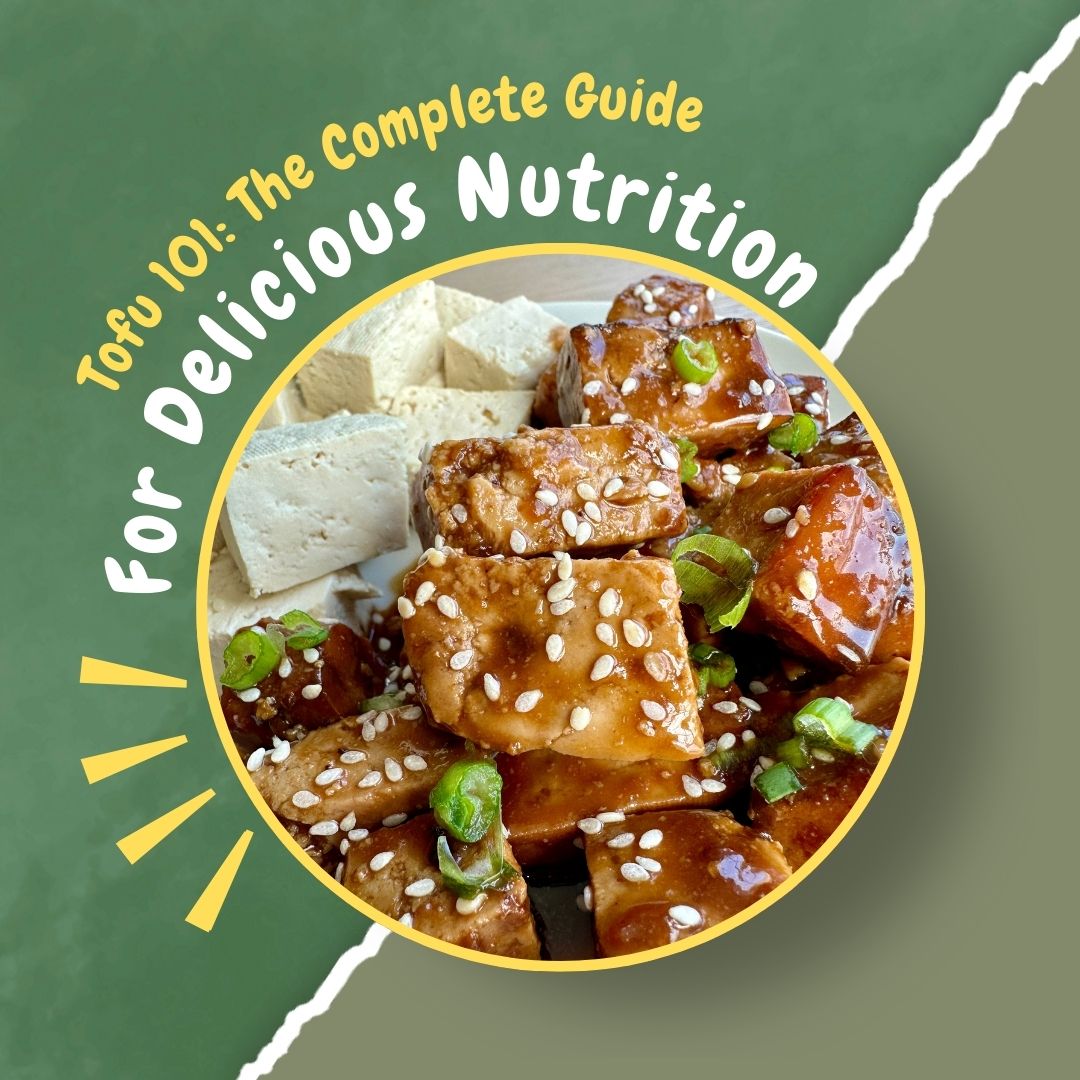Whether you’re new to plant-based eating or just curious about tofu, learning how to cook with it can open up a world of possibilities. Tofu might seem bland or unfamiliar at first, but this plant-based powerhouse is anything but boring. This Tofu 101 guide will walk you through everything you need to know—from choosing the right type to cooking techniques, its beneficial nutrition, and practical tips—so you can enjoy tofu with confidence.
Tofu 101 Basics: What Is Tofu?
It all starts with understanding what tofu actually is. Made from soybeans, tofu is created by curdling fresh soy milk, pressing it into a block, and cooling it – similar to cheese-making. This simple process results in a mild, adaptable food that’s been a staple in Asian cuisines for centuries and is beloved by plant-based eaters everywhere.
Is Tofu a Processed Food?
While it does go through some processing, traditional tofu is made with just three ingredients: soybeans, water, and a coagulant like calcium sulfate or magnesium chloride. It’s far from the ultra-processed foods with long ingredient lists. Most tofu sold today stays close to its whole-food roots, especially when you choose organic or minimally processed varieties.
Types of Tofu and When to Use Them
A key part of Tofu 101 is learning the different types of tofu and how to use each one effectively in your cooking.
- Silken Tofu: Smooth and creamy, silken tofu blends beautifully into soups, sauces, smoothies, and desserts. It’s your go-to for recipes where texture matters.
- Firm Tofu: This tofu is a great all-around choice. With a texture similar to feta, it holds its shape well in stir-fries, bakes, and pan-seared dishes.
- Extra-Firm Tofu: The star of many Tofu 101 recipes, extra-firm tofu is dense, sturdy, and great for frying, baking, or air-frying. It soaks up marinades well and delivers satisfying texture in every bite.
The Secret to Better Tofu? Press or Freeze It
Pressing tofu is one of the simplest prep tips that can completely change the texture and taste of your meals. Removing excess moisture allows tofu to absorb more flavor and crisp up better during cooking.
2 Ways to Press Tofu
- Use a tofu press: Designed for the job, a tofu press makes it quick and easy. You can find a great tofu press option for about $15-$25 online.
- Go DIY: Wrap the tofu in a clean towel, set it on a plate, and place a heavy object like a skillet or books on top. Wait 15–30 minutes and you’re ready to go.
How & Why to Freeze Tofu
Another creative trick is to freeze tofu. It changes the texture in the best way—making it chewier and more absorbent, almost like a sponge. Just drain the tofu, pop it in the freezer (in its original packaging or in an airtight container), and let it freeze solid. When you’re ready to use it, thaw it in the fridge or microwave, then press out the excess water. The result is a firmer texture that soaks up marinades even better, making it perfect for stir-fries, grilling, or crispy baked dishes.
Tofu 101 Nutrition Breakdown
One of the reasons tofu is a standout in plant-based eating is because of its well-rounded nutrition. It’s a great alternative to meat, but how does it really stack up next to something like chicken breast? Here’s a side-by-side comparison based on 100-gram servings:
| Nutrient | Firm Tofu (100g) | Chicken Breast (100g) |
|---|---|---|
| Calories | 144 kcal | 165 kcal |
| Protein | 17 g | 31 g |
| Total Fat | 9 g | 3.6 g |
| Saturated Fat | 1.3 g | 1.0 g |
| Cholesterol | 0 mg | 85 mg |
| Calcium | 683 mg | 11 mg |
| Iron | 2.7 mg | 0.7 mg |
Tofu Nutrition Source: HEALTHLINE
Chicken Breast Nutrition Source: NUTRITIONIX
Even though chicken breast has more protein per serving, tofu still delivers a solid protein punch – especially when you increase the serving size, which is easy to do thanks to its mild flavor and low calorie count.
As you can see from the Heathline article, tofu also contains healthy fats, no cholesterol, and a significant amount of calcium and iron, which are important nutrients often harder to get in a plant-based diet. Chicken breast, while lean and considered high in protein, contains cholesterol and appears to lack the same micronutrient density.
In this Tofu 101 Guide, the focus is on balance. Tofu can be an incredibly satisfying and nourishing option, especially when prepared well and paired with other plant-based staples like a FRESH VEGGIE STIR FRY. Whether you’re looking for heart-smart benefits, lower cholesterol, or more calcium, tofu brings a lot to the table.
But What About The Rumors That Soy Bad For You?
A common concern in any Tofu 101 discussion is soy’s effect on health. Because soy contains phytoestrogens, some worry it might affect hormones or raise the risk of certain cancers. But recent studies show that moderate soy intake is not only safe, it may offer benefits like lowering cholesterol and supporting heart health.
In fact, some have observed that cultures that regularly consume soy foods (like tofu) often show lower rates of certain cancers and cardiovascular disease. As with any food, balance is key. You can dive deeper by checking out this GoodRx article IS SOY BAD FOR YOU? HERE’S WHAT THE SCIENCE SAYS. And as always, check with your doctor to determine what’s right for your body.
Easy Tofu 101 Tips for Success
To get the most out of tofu, try these beginner-friendly techniques—simple tips that work with almost any tofu dish and make it taste amazing.
- Press It First: Removes water for better texture.
- Marinate It: Soy sauce, vinegar, garlic, are a great easy seasoning combo with a little cornstarch to help the tofu brown and absorb flavor.
- Try Different Methods: Pan-fry until crispy, bake (about 30 minutes at 400°), or air-fry (about 20 minutes at 375°).
- Add Bold Flavors: From spicy to sweet, tofu pairs well with nearly any seasoning or sauce, so don’t be afraid to experiment.
Tofu 101 Recipes to Try
Once you get the hang of it, tofu can be a mealtime game-changer. Try one of these easy Tofu 101-inspired ideas:
- General Tso’s Tofu: Toss crispy tofu in a tangy-sweet store-bought bottled General Tso’s sauce and serve with rice and steamed broccoli.
- Tofu Scramble: Crumble tofu with your favorite veggies and spices sauteed for a hearty breakfast or lunch.
- Crispy Tofu Nuggets: Coat tofu cubes in olive oil, panko, nutritional yeast, garlic powder, and onion powder, then bake or air-fry until golden.
- Silken Tofu Chocolate Mousse: Blend 1 cup silken tofu, ½ cup melted dark chocolate chips, 2 tbsp non-dairy milk, 1 tsp vanilla, and 1 tbsp maple syrup. Chill for at least an hour and enjoy a rich, plant-based dessert.
These aren’t full recipes with long ingredient lists—just simple, no-fuss combinations that are perfect for experimenting with tofu. Think of them as easy starting points to help you get comfortable cooking and enjoying tofu in everyday meals.
Your Tofu 101 Takeaway
Tofu 101 isn’t just a lesson in nutrition, it’s an invitation to try something new in the kitchen. Whether you’re aiming to eat more plants, reduce meat, or explore new flavors, tofu makes it easy to do all three. It’s budget-friendly, protein-packed, and incredibly adaptable.
Looking for more help getting started? Download our TOFU 101 BEGINNER PLANT-BASED MEAL GUIDE for quick prep tips and recipes that make tofu easy and delicious. And for more plant-based resources, printables, and weekly tips, head over to OrganizingAPlantBasedLife.com your go-to guide for making plant-based living simpler and more sustainable.






